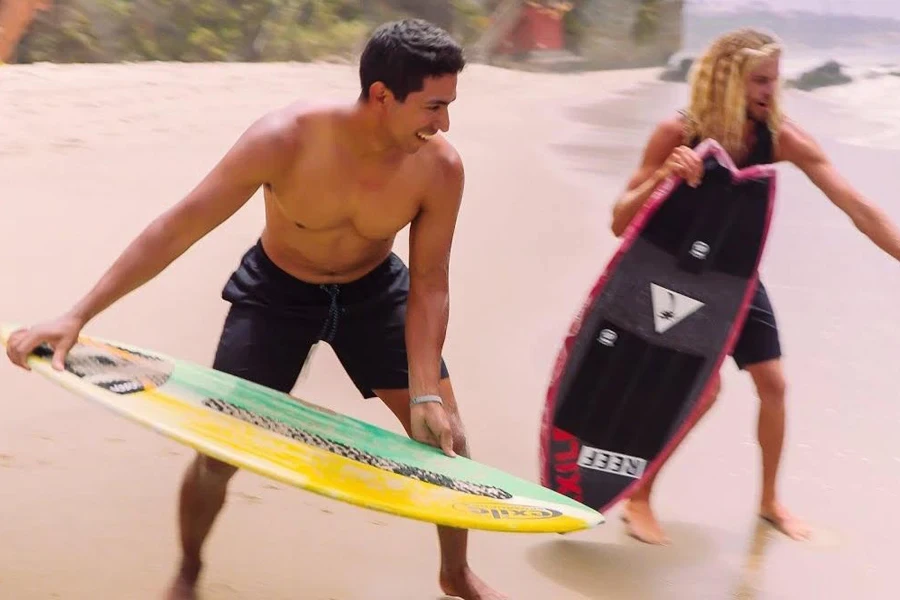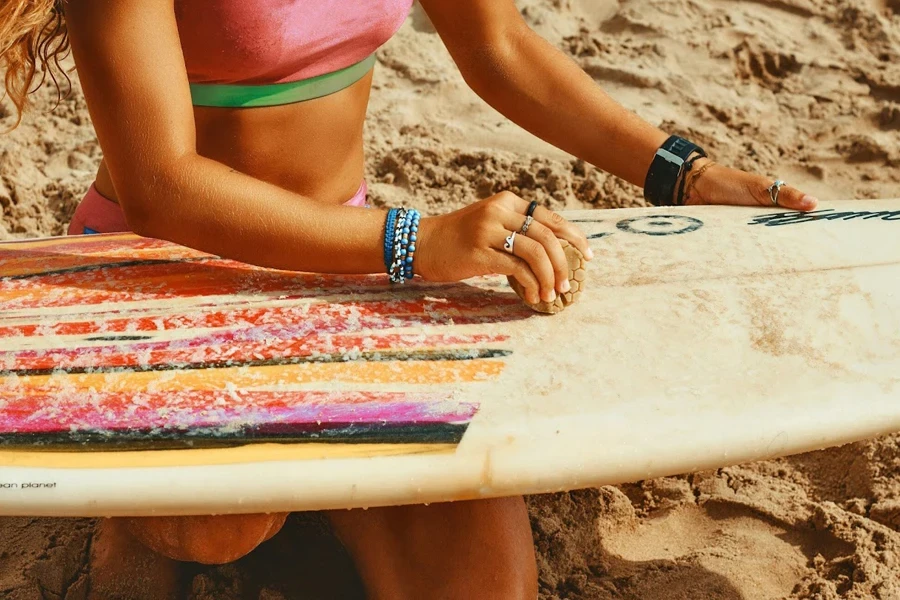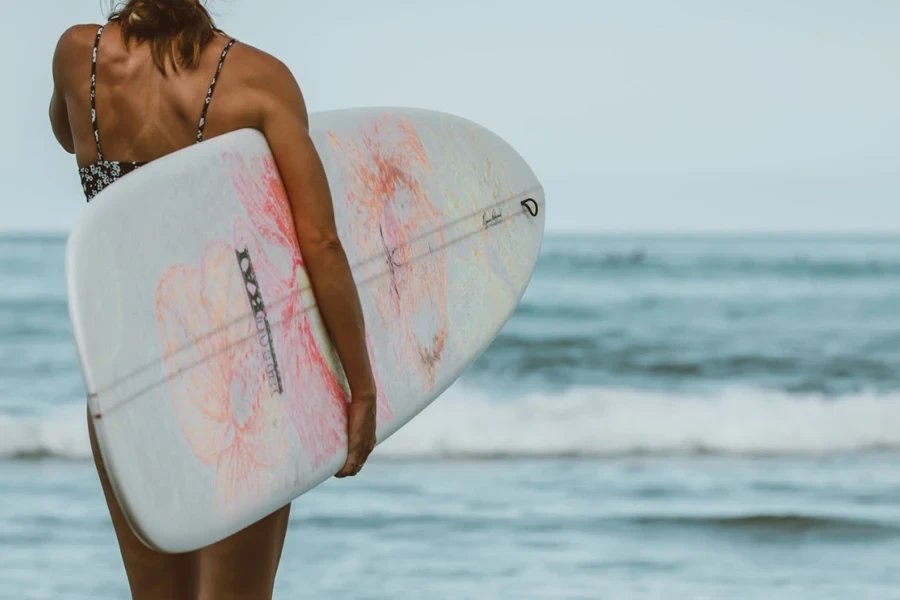Sellers must have the right skimboard offers for newbies and professionals alike if they plan to increase their sales in 2024. From various sought-after skimboard features to the best materials, it is important to understand every parameter before choosing which boards to stock—as this is the only way to ensure your offers are attractive enough to lead potential buyers to make a purchase.
So if you are considering entering the skimboard market, or if you are looking to enhance your offerings, then you have come to the right place! This article will cover everything retailers must know before investing in skimboards in 2024.
Table of Contents
4 tips to help businesses snag the right skimboard for more profits
Rounding up
4 tips to help businesses snag the right skimboard for more profits
1. Skimboard size

The perfect skimboard size depends on the consumer’s skill and size. More skilled skimboarders prefer smaller boards, while beginners often feel better with larger ones. For their weight, experts recommend offering skimboards based on the target consumer’s clothing size.
Check the chart below for more sizing information.
| Skimboarder weight | Skimboard size | Dimensions |
| >80 lbs | XXS | 45.00” x 19.00” |
| 80 to 100 lbs | XS | 48.00” x 19.25” |
| 100 to 140 lbs | S | 51.00” x 19.75” |
| 120 to 160 lbs | M | 52.00” x 20.00” |
| 140 to 180 lbs | ML | 52.25” x 20.25” |
| 160 to 200 lbs | L | 52.50” x 20.50” |
| 180 to 220 lbs | XL | 53.00” x 20.75” |
| 200 to 240 lbs | XXL | 54.00” x 21.50” |
2. Identify the different skimboard constructions

When searching for the perfect skimboard, sellers will likely find more wooden and foam boards. These are the classic (and most popular) materials used for skimboards—but the market has evolved to include other materials for more variety.
I. Wooden skimboards
Wooden skimboards are the sturdiest (and sleekest) options. But where wood enjoys extreme durability, it lacks lightness. These boards have some weight to them when compared to lightweight foam boards. Crafted from birch or mahogany plywood, these bad boys are built for flatland skimming and catching small waves. Even better, wooden skimboards are the go-to for sand skimming or cruising in shallow waters. You’ll often spot them on lakes and rivers, not just on the coastal scene.
However, they don’t tend to handle those deep water adventures well, like skimming straight out from the shore into the waves. If consumers try that with a wooden board, they’ll helplessly watch it sink to the ocean floor. On the bright side, wooden skimboards are tough cookies, but businesses must avoid offering super thin ones.
Despite their heaviness, wooden skimboards are budget-friendly, making them perfect for folks watching their wallets or dipping their toes into skimboarding for the first time. So, if target consumers are not ready to splash out on expensive boards and just want to test the waters, starting with a wooden one might feel like a safer bet.
II. Foam skimboards
Consumers who are really into skimboarding usually lean towards foam boards. The pros love them for being easier to handle on the deep waves! Manufacturers make them from flexible, lightweight foam that floats like a dream. And they’re not just for the seasoned pros—folks of all ages and skill levels can ride the waves with these bad boys.
While foamies have their perks, they have a couple of drawbacks, too. For one, they often cost a pretty penny compared to wooden boards. Plus, they have lower durability—if consumers are not careful with them or have been shredding the waves for a while, foam skimboards may snap on them sooner than they would like.
III. Carbon fiber skimboard
Wooden and foam core boards may be the classic option, but lately, the skimboarding scene has been buzzing about something new: carbon fiber. Yeah, that material they make high-tech stuff out of, like fancy cars and aerospace gear. Now, why the hype for skimboards? Carbon fiber is crazy lightweight and tough as nails. It’s the Superman of materials: strong but not bulky.
So, skimboards made from carbon fiber feel feather-light but are durable enough to take a beating. Carbon fiber skimboards are usually the go-to for hardcore skimboarders, especially if they are all about catching waves. But even if consumers are more into flatland skimming, carbon fiber boards will still do the job. The only downside? They don’t come cheap, making them the last on the list for most beginners.
3. Understand the different wrap types

No matter if a skimboard has a wooden or foam core, there’s one thing they all have in common: the wrap. It’s the flashy outfit for skimboards, showcasing cool colors and designs—with some manufacturers even offering personalization. But here’s the deal: wraps aren’t just there to make the skimboards look sweet. They pull double duty, protecting the core from waterlogging and adding extra muscle to the boards durability.
The best part is consumers have options when it comes to wrap material. They can choose from up to three types, each bringing its own perks to the table. Check below for a closer look at each of them:
I. Carbon
Carbon wraps are the MVPs favored by many skimboarders as the best. No doubt, they are the cream of the crop but can get very expensive. That’s why businesses will only find these waps on higher-end boards. Carbon wraps the toughest skimboard bodyguards. They may not be invincible, but they can take hits like a champ. So, if consumers are all about durability and are willing to dish out, carbon wraps will be their best bet.
II. E-glass
E-glass wraps are the more common variants. They come on most boards, offering enough protection to protect them from regular damage. But remember that E-glass is not the toughest, so anything more than “regular” damage would give them a run for their money.
The E-glass material is a variant of fiberglass, which means it’s flexible enough to handle its own on the waters. But remember, they are not built like tanks, so if consumers are hitting rocky shores or dealing with beach debris, E-glass may show battle scars more easily than other wrap materials. Despite needing extra care, E-glass wraps will still get the job done.
III. S-glass
If consumers want something better than E-glass but less expensive than carbon, sellers can offer them S-glass wraps. These variants are like the beefed-up brother of E-glass, meaning they come at a slightly heftier price tag—still not as expensive as carbon! On the bright side, S-glass doesn’t mess around regarding durability. Because they are stiffer than E-glass, S-glass wraps can help consumers zoom through those waves even faster.
4. Choose the ideal tail shape for consumers

Skimboards can have three main tail shapes, including pintail, swallowtail, and square tail. Although pintails are the most common on less-expensive boards, they are not the best for beginners.
I. Pintail
Manufacturers may also call these tail shapes “twin-tip.” With their tapered back end, consumers can enjoy premium balance with pintails, making it easy to bust out their best moves. And here’s the kicker: consumers can treat boards with this tail shape like a skateboard! It’s why skaters trying their hand at skimboarding love these setups.
II. Square tail
These tail shapes do away with all those fancy curves, offering straight-up squared-off action. Why is it cool? Square tails help boost agility and maneuverability big time, especially when consumers are gliding on the water. That way, they can make those sharp turns and quick moves. This tail shape is the most attractive option for skimboarders hoping to pull off challenging tricks and slick maneuvers.
III. Shallow tail
Some consumers love wider boards for their stability. But the downside is wider boards are not very nimble on the water. That’s where shallow tails save the day. They offer the sweet spot of speed and maneuverability, allowing consumers to pull off those quick moves and slick turns even with a wider board.
Rounding up
While these tips will help businesses find the perfect skimboard, where the consumers will be skimboarding is the last piece of the puzzle. If they prefer the East Coast, they will want heavier, larger boards to conquer those smaller, less powerful waves. But if they are skimming on the West Coast, lighter boards (carbon fibers and foam skimboards) are all they need.
Choosing the perfect skimboard is just the beginning. Businesses must prepare to grab their share of the 90,500 potential consumers searching for skimboards in 2024! So don’t hesitate to make that skimboard investment!




